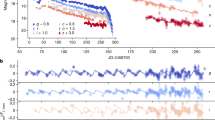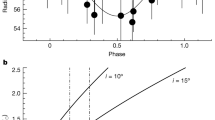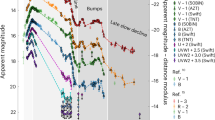Abstract
SUPERNOVA 1993J in the spiral galaxy M81 is the brightest supernova since SN1987A and, like the latter, appears to be another 'peculiar' type II supernova. The available photometry1,2 of the supernova region before the explosion requires the presence of at least two supergiants (one of early spectral type and the other of late type), but the actual progenitor has yet to be identified. Here we show that the explosion of a late-type supergiant can explain the initial sharp peak in the supernova light curve, provided that the star had lost almost all of its hydrogen-rich envelope before the explosion. In our model, the secondary brightening of the supernova, ∼10 days later, is then a consequence of the radioactive decay of 56Ni (and subsequently 56Co) produced in the explosion. The progenitor could have lost its hydrogen-rich envelope either in a strong stellar wind or, as seems more likely, through mass transfer to a companion star. In the latter case, the companion should reappear after the supernova photosphere has receded, the system having become a binary composed of a neutron star with a massive stellar companion.
This is a preview of subscription content, access via your institution
Access options
Subscribe to this journal
Receive 51 print issues and online access
$199.00 per year
only $3.90 per issue
Buy this article
- Purchase on Springer Link
- Instant access to full article PDF
Prices may be subject to local taxes which are calculated during checkout
Similar content being viewed by others
References
Humphreys, R. M., Aldering, G. S., Bryia, C. O. & Thurmes, P. M. IAU Circ. No. 5739 (1993).
Blakeslee, J. & Tonry, J. IAU Circ. No. 5758 (1993).
Abt, H. A. & Levy, S. G. Astrophys. J. Suppl. Ser. 36, 241–258 (1978).
Kraicheva, Z. T., Popova, E. I., Tutukov, A. V. & Yungel'son, L. R. Soviet Astr. 23, 290–296 (1979).
Falk, S. W. & Arnett W. D. Astrophys. J. Suppl. Ser. 33, 515–562 (1977).
Woosley, S. E. & Weaver, T. A. A. Rev. Astr. Astrophys. 24, 205–253 (1986).
Humphreys, R. M. Astrophys. J. 231, 384–387 (1979).
Hsu, J. J. L., Ross, R. R., Podsiadlowski, P. & Joss, P. C. in ESO/EIPC Workshop, Supernova, 1987A and other Supernovae (eds Danziger, I. J. & Kjär, K.) 37–46 (European Southern Laboratory, Garching, 1991).
Hsu, J. J. L. Thesis, Massachusetts Inst. Technol. (1991).
Filippenko, A. V. Astr. J. 96, 1941–1948 (1988).
Filippenko, A. V. & Matheson, T. I.A.U. Circ. No. 5787 (1993).
Chiosi, C. & Maeder, A. A. Rev. Astr. Astrophys. 24, 329–375 (1986).
Lauterborn, D. Astr. Astrophys. 7, 150–159 (1970).
Joss, P. C., Podsiadlowski, P., Hsu, J. J. L. & Rappaport, S. Nature 331, 237–240 (1988).
Podsiadlowski, P., Joss, P. C. & Hsu, J. J. L. Astrophys. J. 391, 246–264 (1992).
Shigeyama, T. & Nomoto, K. Astrophys. J. 360, 242–256 (1990).
Nomoto, K. et al. Nature 364, 507–509 (1993).
Author information
Authors and Affiliations
Rights and permissions
About this article
Cite this article
Podsiadlowski, P., Hsu, J., Joss, P. et al. The progenitor of supernova 1993J: a stripped supergiant in a binary system?. Nature 364, 509–511 (1993). https://doi.org/10.1038/364509a0
Received:
Accepted:
Issue Date:
DOI: https://doi.org/10.1038/364509a0
This article is cited by
-
Supernova remnants: the X-ray perspective
The Astronomy and Astrophysics Review (2012)
Comments
By submitting a comment you agree to abide by our Terms and Community Guidelines. If you find something abusive or that does not comply with our terms or guidelines please flag it as inappropriate.



